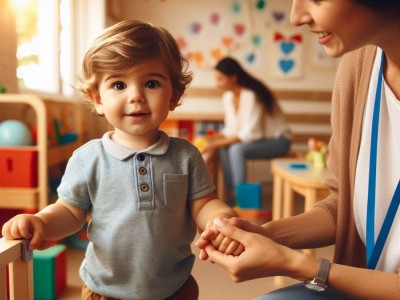Transitioning children into a new room in childcare can be a smooth and positive experience with the right strategies. The following article provides information on When To Transition A Child Into A New Room In Childcare, Strategies To Support Transition To A New Room and more.
1. Preparation
-
Introduce the New Room Gradually: Allow children to visit the new room and meet the new caregivers before the transition.
-
Familiar Objects: Let children bring a favorite toy or blanket to the new room to provide comfort.
2. Communication
-
Inform Parents: Keep parents informed about the transition process and what to expect.
-
Discuss with Children: Talk to the children about the new room and what they will do there. Use positive language to build excitement.
3. Routine and Consistency
-
Maintain Routines: Try to keep the same routines in the new room to provide a sense of stability.
-
Consistent Caregivers: If possible, have a familiar caregiver accompany the children to the new room for the first few days.
4. Engagement and Activities
-
Interactive Activities: Plan engaging activities that children enjoy to help them feel comfortable in the new environment.
-
Group Activities: Encourage group activities to help children bond with their new peers.
5. Support and Reassurance
-
Provide Reassurance: Offer plenty of reassurance and support to children during the transition. Acknowledge their feelings and provide comfort.
-
Monitor Progress: Keep an eye on how children are adjusting and be ready to offer additional support if needed.
6. Feedback and Adjustment
-
Seek Feedback: Ask parents and caregivers for feedback on how the transition is going and make adjustments as necessary.
-
Be Flexible: Be prepared to adapt the transition plan based on the needs of the children.
By following these strategies, you can help ensure a smooth and positive transition for children moving into a new room in childcare.
When To Transition A Child Into A New Room In Childcare
Transitioning a child into a new room in childcare is an important step that should be carefully planned to ensure a smooth and positive experience. Here are some key considerations for when to make this transition:
1. Developmental Readiness
-
Age and Milestones: Typically, transitions occur when a child reaches a certain age or developmental milestone. For example, moving from an infant room to a toddler room might happen around 18 months to 2 years.
-
Skills and Abilities: Consider the child's physical, social, and emotional readiness. Are they able to handle the activities and routines of the new room?
2. Emotional Readiness
-
Comfort and Confidence: Ensure the child feels comfortable and confident in their current environment before transitioning. If they are showing signs of anxiety or distress, it might be best to wait a bit longer.
-
Attachment to Caregivers: Consider the child's attachment to their current caregivers. A gradual transition can help ease the separation.
3. Communication with Parents
-
Parental Input: Discuss the transition with the child's parents and consider their input. They can provide valuable insights into their child's readiness and any concerns they might have.
-
Informing Parents: Keep parents informed about the transition process and what to expect.
4. Timing and Planning
-
Gradual Transition: Plan a gradual transition where the child spends short periods in the new room, gradually increasing the time as they become more comfortable.
-
Consistent Routine: Try to maintain a consistent routine to provide a sense of stability and security for the child.
5. Observing the Child
-
Behavioral Cues: Observe the child's behavior for signs that they are ready for the transition, such as showing interest in activities in the new room or interacting positively with children and caregivers in the new environment.
-
Feedback from Caregivers: Get feedback from the child's current caregivers about their readiness and any observations they have made.
By considering these factors and planning the transition carefully, you can help ensure a smooth and positive experience for the child.
Strategies To Support Transition To A New Room
- Ask parents if they agree with your assessment that the child is ready to move on.
- Discuss the transition plans with the workers in the new space.
- Arrange for the youngster and their key person to visit the room together for a number of brief sessions.
- Using the observations you have made and considering whether there is a specific adult the child is gravitating toward that could become the new key person
- Review how the sessions are going with the parents and staff in the new room by creating a photo book with pictures of the staff and kids in the new space so you can sit and look at it together
- Extend the duration of the sessions and start implementing moments when the youngster is left in the room with the new staff member.
- Keep an eye on the transition plans, go over them again, and, if everything is going well, extend the sessions until the child feels content and at ease being left in the new room.
Remember: Children should never be moved up an age range just because they have reached a specific age. They must only begin a transition when they are emotionally ready, can be fully supported and when the parents are in full agreement.
Further Reading
Creating Smooth Transitions In Early Childhood Settings
Child Behaviour: Transitions
Guide To Transitions Between Activities In Early Childhood Services
Moving Up - Transition Form
Transitioning To A New Room, Your ELC AU
Transitions: Moving In, Moving Up and Moving On, ACECQA
Moving Rooms At Nursery And Supporting Babies' Transitions, MY NDNA UK







 As an Educator in Australia, your pay rate falls under the Children’s Services Award 2010. This award states the minimum amount that an employer can
As an Educator in Australia, your pay rate falls under the Children’s Services Award 2010. This award states the minimum amount that an employer can When working as a qualified Early Childhood Teacher (with a university degree) within a service, your rate of pay will come from the Educational Services
When working as a qualified Early Childhood Teacher (with a university degree) within a service, your rate of pay will come from the Educational Services When working as a Diploma Qualified Educator your pay rate is from the Children's Services Award 2010. This Award states your minimum rate of pay
When working as a Diploma Qualified Educator your pay rate is from the Children's Services Award 2010. This Award states your minimum rate of pay When working as a Cert 3 Qualified Educator, your pay rate is from the Children's Services Award 2010. This Award states your minimum rate of
When working as a Cert 3 Qualified Educator, your pay rate is from the Children's Services Award 2010. This Award states your minimum rate of Educational Leaders play a crucial role in their early childhood service by ensuring that the educational program aligns with best practices and supports the holistic
Educational Leaders play a crucial role in their early childhood service by ensuring that the educational program aligns with best practices and supports the holistic In early childhood education and care, ratios are more than a technicality—they are a frontline safeguard. Every child deserves responsive supervision, emotional connection, and developmental
In early childhood education and care, ratios are more than a technicality—they are a frontline safeguard. Every child deserves responsive supervision, emotional connection, and developmental Here’s a comprehensive Mobile Phone and Smart Watch Policy tailored for early childhood education and care (ECEC) services in Australia, aligned with the latest 2025
Here’s a comprehensive Mobile Phone and Smart Watch Policy tailored for early childhood education and care (ECEC) services in Australia, aligned with the latest 2025 With the new national child safety reforms kicking in on 1 September 2025, early childhood services like yours have a real opportunity to lead the
With the new national child safety reforms kicking in on 1 September 2025, early childhood services like yours have a real opportunity to lead the The Sea of Fish Challenge is a national initiative that invites children, educators, families, and communities to create and display fish artworks as a symbol
The Sea of Fish Challenge is a national initiative that invites children, educators, families, and communities to create and display fish artworks as a symbol Across the early childhood education and care sector, educators are sounding the alarm: current staffing ratios are insufficient to deliver safe, meaningful, and developmentally appropriate
Across the early childhood education and care sector, educators are sounding the alarm: current staffing ratios are insufficient to deliver safe, meaningful, and developmentally appropriate


